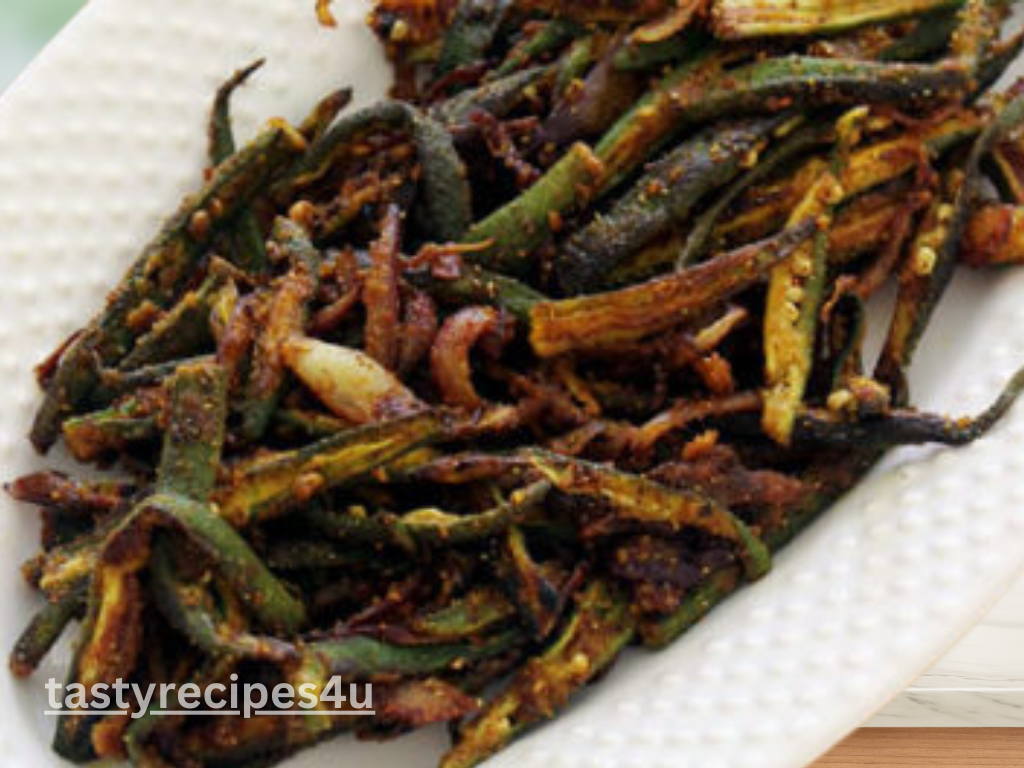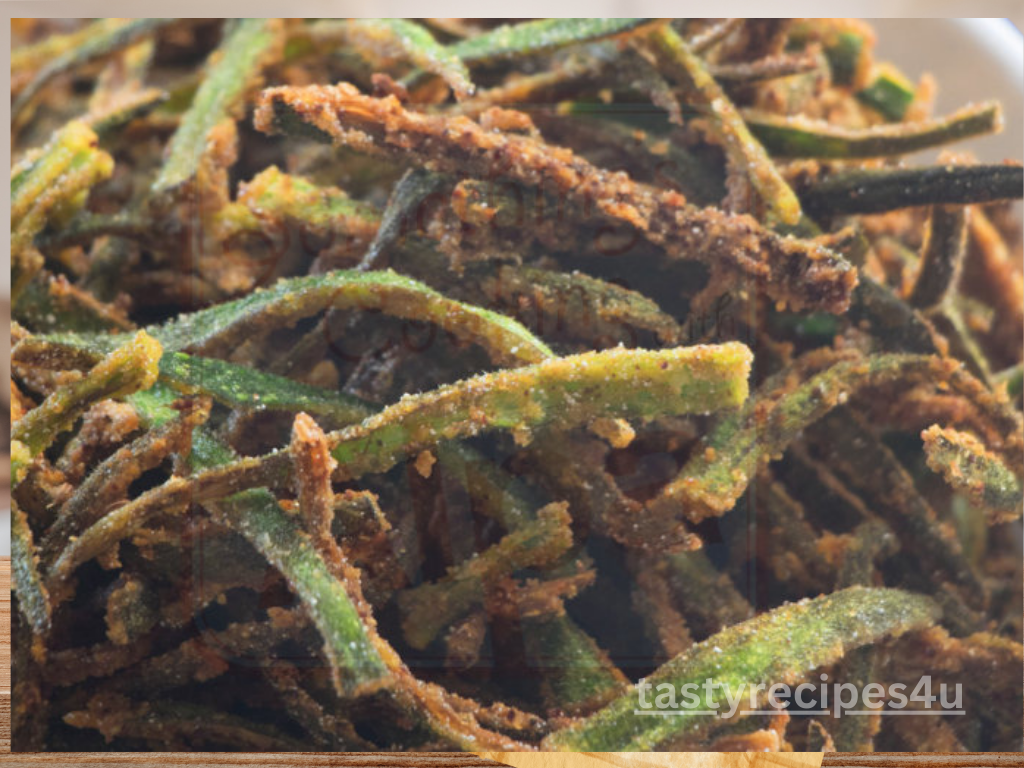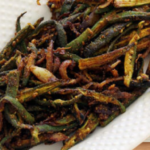Crispy Bhindi Fry | Bhindi Fry Recipe
Welcome to the delicious world of bhindi fry! If you’re a fan of crispy, flavorful, and easy-to-make dishes, then bhindi fry is the perfect recipe for you. Bhindi, also known as okra or lady’s finger, is a popular vegetable in Indian cuisine. This simple yet delightful dish is a staple in many households, enjoyed for its crunchy texture and savory taste. Whether you’re a seasoned cook or a beginner, this bhindi fry recipe will guide you through the steps to create a mouthwatering dish that will leave you and your family wanting more.

How to make Bhindi fry
Ingredients Needed
Main Ingredients
- Fresh bhindi (okra): 500 grams
- Onion: 1 large, finely sliced
- Tomato: 1 medium, finely chopped
Spices and Seasonings
- Turmeric powder: 1/2 teaspoon
- Red chili powder: 1 teaspoon
- Coriander powder: 1 teaspoon
- Cumin seeds: 1/2 teaspoon
- Garam masala: 1/2 teaspoon
- Amchur powder (dry mango powder): 1/2 teaspoon
- Salt: to taste
- Oil: 3 tablespoons
Optional Ingredients
- Green chilies: 2, slit lengthwise
- Garlic: 3-4 cloves, minced
- Fresh coriander leaves: for garnish
Choosing the Right Bhindi
Types of Bhindi
For the best results, choose tender and fresh bhindi. Look for small to medium-sized pods that are bright green and free from blemishes. Avoid bhindi that is too large or hard, as it can be tough and fibrous.
Tips for Selecting Bhindi
Gently press the tip of the bhindi; it should snap off easily. This indicates that the bhindi is fresh and tender. Additionally, ensure that the pods are firm and not wilted.

Preparation Steps for Bhindi Fry
Washing and Drying Bhindi
Thoroughly wash the bhindi under running water to remove any dirt or pesticides. Using a fresh paper towel or kitchen towel, pat them dry. It’s important to ensure that the bhindi is completely dry to prevent it from becoming slimy during cooking.
Cutting the Bhindi
Trim the ends of the bhindi and cut them into thin slices or rounds, about 1/2 inch thick. You can also cut them into 2-inch pieces if you prefer a chunkier texture.
Cooking the Bhindi Fry
Step 1: Heating the Oil
In a large, heavy-bottomed skillet or pan, heat the oil over medium heat When the oil is heated, add the cumin seeds and allow them to pop.
Step 2: Adding Aromatics
Finely slice the onions and add to the pan; sauté until golden brown. This should take about 5-7 minutes. If you’re using garlic, add it along with the onions and sauté until fragrant.
Step 3: Cooking the Bhindi
Add the cut bhindi to the pan and stir well to coat it with the oil and onions. Cook on medium-high heat for about 10-12 minutes, stirring occasionally to ensure even cooking. The bhindi should become slightly crisp and start to brown.
Step 4: Adding Spices
Stir in the salt, red chili powder, coriander powder, and turmeric powder.
Mix well to combine and cook for another 5 minutes until the spices are well absorbed and the bhindi is cooked through.
Step 5: Adding Tomatoes
When using, add the chopped green chilies and tomatoes. Stir well and cook for an additional 3-4 minutes until the tomatoes soften and blend with the bhindi.
Step 6: Final Touches
Sprinkle garam masala and amchur powder over the bhindi. Mix well and cook for another minute. Adjust the seasoning as needed. Just before serving, add some fresh coriander leaves as a garnish.

Serving Suggestions
Bhindi fry is a versatile dish that pairs well with various Indian staples. Serve it with hot chapatis, parathas, or naan for a satisfying meal. It also complements a simple dal and rice combination perfectly.
Serve the bhindi fry hot, garnished with fresh coriander leaves. It makes for a great side dish in a larger meal or can be enjoyed as a main dish with bread or rice.
Health Benefits of Bhindi
Nutritional Value
Bhindi is a low-calorie vegetable rich in dietary fiber, vitamins C and K, and folate. It’s also a good source of antioxidants, which help in fighting inflammation and promoting overall health.
Digestive Benefits
The high fiber content in bhindi aids in digestion and helps maintain a healthy digestive system. It can also help regulate blood sugar levels, making it a good option for people with diabetes.
Common Mistakes to Avoid
Not Drying Bhindi Properly
One of the most common mistakes is not drying the bhindi thoroughly after washing. Any moisture can cause the bhindi to become slimy during cooking.
Overcrowding the Pan
To ensure the bhindi cooks evenly and becomes crispy, avoid overcrowding the pan. Cook in batches if necessary to give each piece enough space to fry properly.

Tips & Tricks for Perfect Bhindi Fry
Balancing Flavors
To suit your tastes, adjust the spice levels. Reduce the amount of red chili powder if you’d rather it taste less spicy. For a tangier taste, you can increase the amchur powder slightly.
Ensuring Crispy Bhindi
To achieve a crispy texture, cook the bhindi on medium-high heat and avoid covering the pan. Stir occasionally to prevent burning, but not too frequently as it can make the bhindi mushy.
Variations of Bhindi Fry
Spicy Bhindi Fry
For an extra kick, add more green chilies or a pinch of black pepper. You can also try adding a dash of chaat masala for a tangy, spicy twist.
South Indian Style Bhindi Fry
Incorporate South Indian flavors by adding curry leaves and mustard seeds along with the cumin seeds. You can also add a bit of grated coconut towards the end for a unique texture and taste.
Fixing Issues with Your Bhindi Fry
Dealing with Slimy Bhindi
If your bhindi turns out slimy, try adding a teaspoon of lemon juice while cooking. This can help reduce the sliminess. Also, ensure the bhindi is dry before cooking and avoid covering the pan.
Fixing Undercooked Bhindi
If the bhindi is undercooked, simply cook it for a few more minutes. Add a little more oil if needed to prevent sticking and ensure even cooking.
Conclusion
Bhindi fry is a delightful dish that brings together the flavors of fresh okra and aromatic spices. With this step-by-step guide, you can easily create a delicious and crispy bhindi fry that will be a hit at your dining table. Remember to select fresh bhindi, balance the spices to your liking, and enjoy the process of making this wonderful dish. Happy cooking!
FAQs (Frequently Asked Questions)
How long does bhindi fry last?
Bhindi fry can be stored in an airtight container in the refrigerator for up to 2-3 days. Reheat it in a pan before serving to regain its crispy texture.
Can I use frozen bhindi for this recipe?
While fresh bhindi is preferred, you can use frozen bhindi if fresh is not available. Thaw it completely and pat it dry before cooking to minimize sliminess.
What kind of oil is best for bhindi fry?
Any neutral oil like vegetable oil, sunflower oil, or canola oil works well for bhindi fry. You can also use mustard oil for an added depth of flavor.
How do I prevent bhindi from becoming slimy?
Ensure the bhindi is completely dry before cooking. Cook on medium-high heat without covering the pan, and avoid overcrowding the pan.
Can I adjust the spice level?
Absolutely! Feel free to adjust the amount of red chili powder and green chilies to suit your taste preferences.


